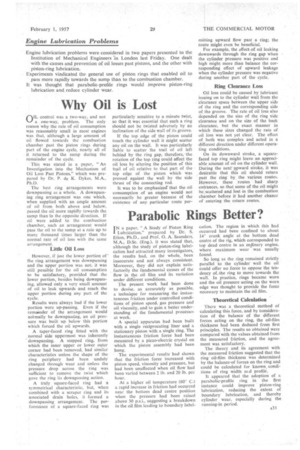Why Oil is Lost
Page 67

If you've noticed an error in this article please click here to report it so we can fix it.
Oil, control was a two-way, and not a one-way, problem. The only reason why the rate of oil consumption was reasonably small in most engines was that, although a large amount of oil flowed towards the combustion chamber past the piston rings during part of the engine cycle, nearly all of it returned to the sump during the remainder of the cycle.
This was stated in a paper, "An Investigation into the Mechanism of Oil Loss Past Pistons," which was prepared by Dr. P. de K. Dykes. M.A.. Ph.D.
The best ring arrangements were downpassing as a whole. A downpassing ring arrangement was one which, when supplied with an ample amount of oil from both above and below, passed the oil more rapidly towards the sump than in the opposite direction. If oil were added to the combustion chamber, such an arrangement would pass the oil to the sump at a rate up to many thousand times larger than the normal rate of oil loss with the same arrangement.
Little Oil Loss
However, if just the lower portion of' the ring arrangement was downpassing and the upper portion was not, it was still possible for the oil consumption to he satisfactory, provided that the lower portion, besides being downpassing, allowed only a very small amount of oil to leak upwards and reach the upper portion during any part of the cycle.
Results were always bad if the lower portion were up-passing. Even if the remainder of the arrangement would normally be downpassing, an oil pressure was built up below this portion which forced the oil upwards.
A taper-faced ring fitted with the normal side uppermost was inherently downpassing. A stepped ring, from which the inner upper or lower outer corner had been removed, had similar characteristics unless the shape of the ring periphery had been unduly changed through wear and unless the pressure drop across the ring was sufficient to remove the twist which gave thc ring its downpassing action.
A truly square-faced ring had a symmetrical characteristic, but, when combined with a scraper ring and its associated drain holes, it formed a downpassing arrangement. The performance of a square-faced ring was particularly sensitive to a minute twist, so that it was essential that such a ring should not be twisted adversely by an inclination of the side wall of its groove.
If the top edge of the piston could touch the cylinder wall it might scatter any oil on the wall. It was particularly liable to scatter the trail of oil left behind by the ring gap, therefore, the rotation of the top ring could affect the oil loss by altering the position of this trail of oil relative to that part of the top edge of the piston which was pressed against the wall by the side thrust of the connecting rod.
It was to be emphasized' that the oil consumption of an engine would not necessarily be greater because of the existence of any particular route per mitting upward flow past a ring; the route might even be beneficial.
For example, the effect of oil leaking downwards through the ring gap when the cylinder pressure was positive and high might more than balance the corresponding effect of upward leakage when the cylinder pressure was negative during another part of the cycle.
Ring Clearance Loss Oil loss could be caused by lubricant issuing on to the cylinder wall from the clearance space between the upper side of the ring and the corresponding side of the groove. The rate of oil loss also depended on the size of the ring side clearance and on the size of the back clearance, but the exact manner in which these sizes changed the rate of oil loss was not yet clear. The effect of both was complex and acted in a different direction under different operating conditions.
On its downward stroke, a squarefaced top ring might leave an appreciable amount of oil on the cylinder wall. During the next upward stroke, it was desirable that this oil should return past the ring by the various routes. However, these routes had sharp entrances, so that some of the oil might be scattered and lost in the combustion chamber before it had another chance of entering the return routes.




































































































